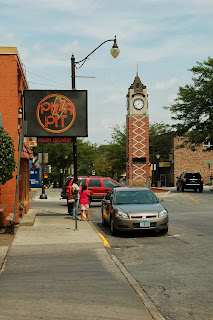 While
traveling in the Midwest this past summer, my traveling companion and I took a
day trip to Ames, Iowa, home of Iowa State.
While
traveling in the Midwest this past summer, my traveling companion and I took a
day trip to Ames, Iowa, home of Iowa State.
Sidenote: On
the freeway between Des Moines and Ames, we noted an exit for “High
Trestle”. It sounded vaguely
interesting, but not intriguing enough to take the offramp. A few weeks after my return home, I learned
that the High Trestle, which involves neon lighting and
other decoration on a former railroad trestle, is one of the top ten public art
projects in the U.S. Oops.
Despite that
oversight, Ames was worth the trip. The
campus sprawled more than I would have liked.
As a Cal grad, I remain partial to campuses that are compact and highly walkable. But touring the campus and surrounding
residential districts made for an enjoyable day.
Of
particular interest to me were the first blocks of Welch Avenue immediately
south of campus, an area known as Campus Town.
While
walking through Campus Town, it struck me that college urbanism is a specific
form of urbanism, one that is particularly pure and illustrative.
College
urbanism is a highly functional, almost distilled, form of urbanism. It’s a fundamentally walkable setting that
serves its residents well, but has neither frills nor an upper end. Most of the buildings are aging and held
together with duct tape. The retail
focus is directed like a laser at the needs of students living for the first
time away from the parental roof.
Plentiful alcohol, cheap food, places where one can sit and talk until
after midnight, and perhaps a small grocery store pretty much cover it.
And the district
adjoining a college urban core is usually dense multi-family dwellings, whether
dorms, co-ops, fraternities, sororities, or apartments. Owner-occupied real estate, whether
condominiums or single-family homes, is rare and usually located further from
the core.
Not every
college exhibits college urbanism.
Colleges that are primarily commuter schools don’t. Nor do schools that sprawl so far that campus
shuttles are used, undermining the need for walkable districts at the campus
edges. Another exception is colleges
where many students own cars and aren’t dependent on walkable locations.
But where
none of those exist, college urbanism can flourish. On the Cal campus, Telegraph Avenue would
seem to be an example of college urbanism known nationwide. But most Cal students know that Telegraph has
become a caricature of itself. Durant
Avenue is where the real students go for their retail and entertainment needs.
As a Cal
engineering student, the Northside was more my natural habitat. The first block of Euclid Avenue above campus
was where I learned to appreciate Asian food, played liar’s dice every Friday
evening, caught the occasional movie, and even did some grocery shopping.
And today, forty years later, Northside doesn’t look particularly different.
College urbanism can have remarkable staying power. Gentrification is rare. For one, people with more money usually don’t want to live surrounded by students. Also, there is always a new generation of economically-strapped but eager-for-fun college students to sustain the existing businesses.
In some
places, college urbanism is muted by interaction with the broader
community. The downtown core of Chico,
immediately south of the Chico State campus, is an example. Elements of college urbanism are intermingled
with stores and restaurants that serve to the more mature members of the
community. It’s a more sedate form of
college urbanism, but still attractive.
And the economic power of the students provides a base that stabilizes a
downtown that might otherwise be at risk.
Davis offers
a type of urbanism similar to that of Chico, where the UC Davis students and
town people often mingle. From my one
visit to the proximity of the University of the Pacific campus in Stockton, the
same balance seemed to exist there.
Another example is Shattuck Avenue in Berkeley, where the retail and
entertainment offerings are a full step above either Southside or
Northside. It’s where the parents of Cal
students go for dinner when visiting Berkeley.

Looking back
at Ames, Campus Town felt much like Northside in Berkeley. Although there was a greater accommodation
for cars, which detracted from the urbanism.
Also, Campus
Town offers a good illustration of why college urbanism is usually composed of
older buildings. Trying to build new
structures that meet the price points of college students can result in unfortunate
architectural compromises, such as the Welch Crown Center. It would have been better to have bought more
rolls of duct tape.

I’m unsure
where the summer of 2014 will take me, but I’ll be paying particular attention
to the periphery of college campuses whenever I can. I’ll likely see some solid but unadorned urbanism.
(Note: All photos are of Campus Town at Iowa State.)
As always,
your questions or comments will be appreciated.
Please comment below or email me.
And thanks for reading. - Dave Alden (davealden53@comcast.net)
No comments:
Post a Comment